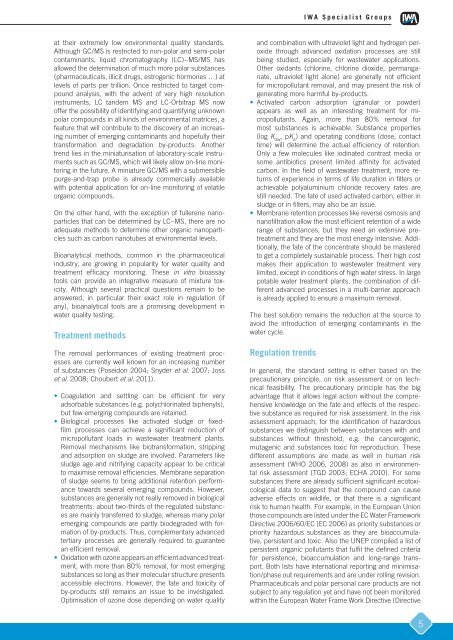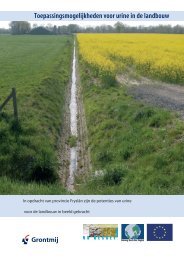IWA Specialist Group Directory - Nieuwe Sanitatie - Stowa
IWA Specialist Group Directory - Nieuwe Sanitatie - Stowa
IWA Specialist Group Directory - Nieuwe Sanitatie - Stowa
Create successful ePaper yourself
Turn your PDF publications into a flip-book with our unique Google optimized e-Paper software.
at their extremely low environmental quality standards.<br />
Although GC/MS is restricted to non-polar and semi-polar<br />
contaminants, liquid chromatography (LC)–MS/MS has<br />
allowed the determination of much more polar substances<br />
(pharmaceuticals, illicit drugs, estrogenic hormones …) at<br />
levels of parts per trillion. Once restricted to target compound<br />
analysis, with the advent of very high resolution<br />
instruments, LC tandem MS and LC-Orbitrap MS now<br />
offer the possibility of identifying and quantifying unknown<br />
polar compounds in all kinds of environmental matrices, a<br />
feature that will contribute to the discovery of an increasing<br />
number of emerging contaminants and hopefully their<br />
transformation and degradation by-products. Another<br />
trend lies in the miniaturisation of laboratory-scale instruments<br />
such as GC/MS, which will likely allow on-line monitoring<br />
in the future. A miniature GC/MS with a submersible<br />
purge-and-trap probe is already commercially available<br />
with potential application for on-line monitoring of volatile<br />
organic compounds.<br />
On the other hand, with the exception of fullerene nanoparticles<br />
that can be determined by LC–MS, there are no<br />
adequate methods to determine other organic nanoparticles<br />
such as carbon nanotubes at environmental levels.<br />
Bioanalytical methods, common in the pharmaceutical<br />
industry, are growing in popularity for water quality and<br />
treatment effi cacy monitoring. These in vitro bioassay<br />
tools can provide an integrative measure of mixture toxicity.<br />
Although several practical questions remain to be<br />
answered, in particular their exact role in regulation (if<br />
any), bioanalytical tools are a promising development in<br />
water quality testing.<br />
Treatment methods<br />
The removal performances of existing treatment processes<br />
are currently well known for an increasing number<br />
of substances (Poseidon 2004; Snyder et al. 2007; Joss<br />
et al. 2008; Choubert et al. 2011).<br />
• Coagulation and settling can be effi cient for very<br />
adsorbable substances (e.g. polychlorinated biphenyls),<br />
but few emerging compounds are retained.<br />
• Biological processes like activated sludge or fi xedfi<br />
lm processes can achieve a signifi cant reduction of<br />
micropollutant loads in wastewater treatment plants.<br />
Removal mechanisms like biotransformation, stripping<br />
and adsorption on sludge are involved. Parameters like<br />
sludge age and nitrifying capacity appear to be critical<br />
to maximise removal effi ciencies. Membrane separation<br />
of sludge seems to bring additional retention performance<br />
towards several emerging compounds. However,<br />
substances are generally not really removed in biological<br />
treatments: about two-thirds of the regulated substances<br />
are mainly transferred to sludge, whereas many polar<br />
emerging compounds are partly biodegraded with formation<br />
of by-products. Thus, complementary advanced<br />
tertiary processes are generally required to guarantee<br />
an effi cient removal.<br />
• Oxidation with ozone appears an effi cient advanced treatment,<br />
with more than 80% removal, for most emerging<br />
substances so long as their molecular structure presents<br />
accessible electrons. However, the fate and toxicity of<br />
by-products still remains an issue to be investigated.<br />
Optimisation of ozone dose depending on water quality<br />
<strong>IWA</strong> <strong>Specialist</strong> <strong>Group</strong>s<br />
and combination with ultraviolet light and hydrogen peroxide<br />
through advanced oxidation processes are still<br />
being studied, especially for wastewater applications.<br />
Other oxidants (chlorine, chlorine dioxide, permanganate,<br />
ultraviolet light alone) are generally not effi cient<br />
for micropollutant removal, and may present the risk of<br />
generating more harmful by-products.<br />
• Activated carbon adsorption (granular or powder)<br />
appears as well as an interesting treatment for micropollutants.<br />
Again, more than 80% removal for<br />
most substances is achievable. Substance properties<br />
(log Kow , pKa ) and operating conditions (dose, contact<br />
time) will determine the actual effi ciency of retention.<br />
Only a few molecules like iodinated contrast media or<br />
some antibiotics present limited affi nity for activated<br />
carbon. In the fi eld of wastewater treatment, more returns<br />
of experience in terms of life duration in fi lters or<br />
achievable polyaluminium chloride recovery rates are<br />
still needed. The fate of used activated carbon, either in<br />
sludge or in fi lters, may also be an issue.<br />
• Membrane retention processes like reverse osmosis and<br />
nanofi ltration allow the most effi cient retention of a wide<br />
range of substances, but they need an extensive pretreatment<br />
and they are the most energy intensive. Additionally,<br />
the fate of the concentrate should be mastered<br />
to get a completely sustainable process. Their high cost<br />
makes their application to wastewater treatment very<br />
limited, except in conditions of high water stress. In large<br />
potable water treatment plants, the combination of different<br />
advanced processes in a multi-barrier approach<br />
is already applied to ensure a maximum removal.<br />
The best solution remains the reduction at the source to<br />
avoid the introduction of emerging contaminants in the<br />
water cycle.<br />
Regulation trends<br />
In general, the standard setting is either based on the<br />
precautionary principle, on risk assessment or on technical<br />
feasibility. The precautionary principle has the big<br />
advantage that it allows legal action without the comprehensive<br />
knowledge on the fate and effects of the respective<br />
substance as required for risk assessment. In the risk<br />
assessment approach, for the identifi cation of hazardous<br />
substances we distinguish between substances with and<br />
substances without threshold, e.g. the cancerogenic,<br />
mutagenic and substances toxic for reproduction. These<br />
different assumptions are made as well in human risk<br />
assessment (WHO 2006, 2008) as also in environmental<br />
risk assessment (TGD 2003; ECHA 2010). For some<br />
substances there are already suffi cient signifi cant ecotoxicological<br />
data to suggest that the compound can cause<br />
adverse effects on wildlife, or that there is a signifi cant<br />
risk to human health. For example, in the European Union<br />
those compounds are listed under the EC Water Framework<br />
Directive 2006/60/EC (EC 2006) as priority substances or<br />
priority hazardous substances as they are bioaccumulative,<br />
persistent and toxic. Also the UNEP compiled a list of<br />
persistent organic pollutants that fulfi l the defi ned criteria<br />
for persistence, bioaccumulation and long-range transport.<br />
Both lists have international reporting and minimisation/phase<br />
out requirements and are under rolling revision.<br />
Pharmaceuticals and polar personal care products are not<br />
subject to any regulation yet and have not been monitored<br />
within the European Water Frame Work Directive (Directive<br />
5



